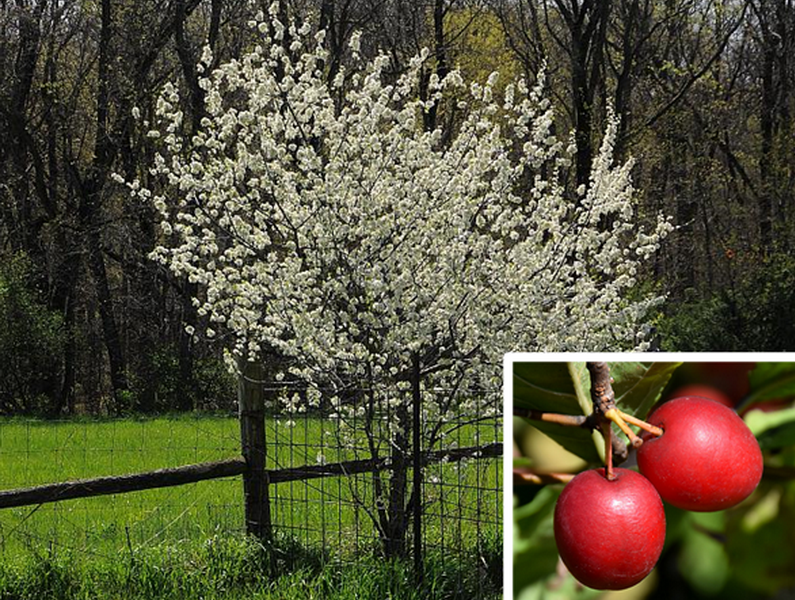American Plum Tree
Prunus americana
Click here to download a PDF of this plant information page (for printing).

Sun Exposure: Full Sun, Part Sun
Season of Interest: Spring, Summer, Fall
Bloom Time: March - April
Bloom Color: White
Height: 15 ft.
Spread: 12 ft.
Spacing: 20 ft.
Water Needs: Average
Maintenance: Prune for shape
Soil Type: Clay, Loam, Sandy
Soil pH: Acidic, Neutral, Alkaline
Soil Drainage: Well drained
Pests: Squirrels eat the fruit
Diseases: Black knot, Canker, Leafspot
Wildlife: Bees, Butterflies, Small mammals

Description:
A beautiful tree when in bloom, the American plum is fast growing, produces delicious edible fruit in late summer, and has showy red to purple foliage in the fall. The fruit can be eaten raw but is best used to make jams and jellies. This tree can also be trained to grow hedge rows by allowing the suckers to mature in the desired layout. All other suckers should be removed.
This tree provides good cover for songbirds and small mammals year-round as well as nectar for pollinators and is a larval host plant for several species of butterflies. You may see the Coral Hairstreak, the Eastern Tiger Swallowtail, the Spring Azure, the Viceroy, and the Red-spotted Purple butterfly. The fruits are eaten by songbirds, wild turkeys, quail, white-tailed deer, and small mammals. For more information see
plants.ces.ncsu.edu/plants/prunus-americana
Care and Growing Tips:
Water plum trees heavily during the first growing season, regularly when fruiting, and during extended dry spells. If you're growing your plum tree in a container, regular watering is needed so the soil does not dry out. Keep an eye on the base of the tree and make sure that a radius of at least 3ft (1m) is kept weed-free. Mulching with compost or well-rotted manure combats weed growth, as well as keeping the ground moist. But take care to keep the mulch away from the trunk.
You can add an organic fertilizer (like fish, blood and bone) before laying your mulch in spring. A second mulch application in autumn (including shredded bark) will keep the soil warmer and well-nourished as the weather cools.
Thinning out the fruit tree will ensure that the tree’s energies are directed towards developing only the best fruits. It also helps to prevent bent or broken branches due to overloading – and allows good air flow and sunlight to access all areas. To do this, remove the surplus when fruits are forming in June-July. Leave one fruit every 2-3in (5-8cm), or a pair every 6in (15cm). Prop up loaded branches as fruits reach maximum density. You don’t want the branch to snap after patiently waiting for your plums for so long! To prevent branches snapping, give the more laden branches a boost with a Y-shaped support.